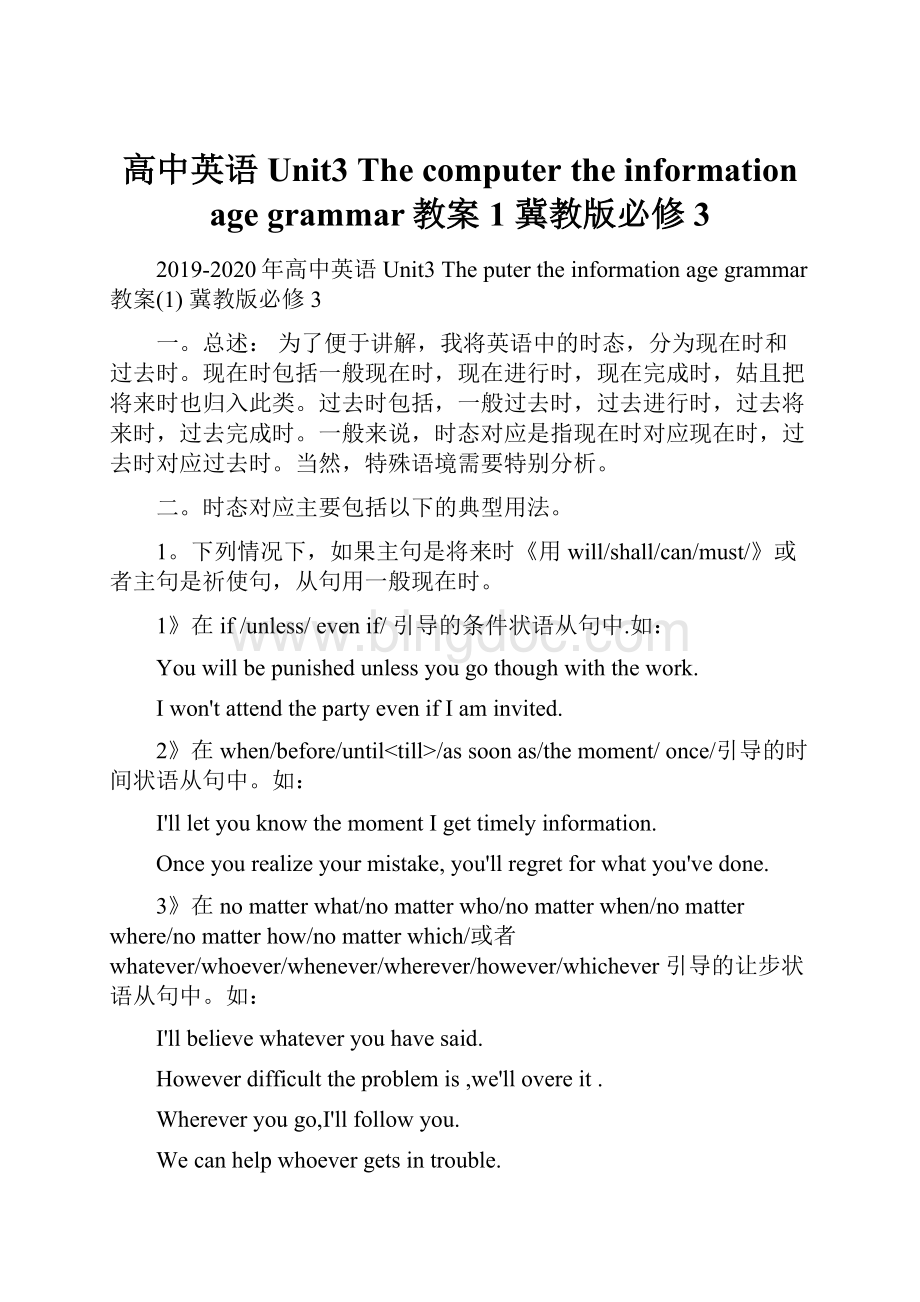高中英语 Unit3 The computer the information age grammar教案1 冀教版必修3Word下载.docx
《高中英语 Unit3 The computer the information age grammar教案1 冀教版必修3Word下载.docx》由会员分享,可在线阅读,更多相关《高中英语 Unit3 The computer the information age grammar教案1 冀教版必修3Word下载.docx(12页珍藏版)》请在冰点文库上搜索。

Whereveryougo,I'
llfollowyou.
Wecanhelpwhoevergetsintrouble.
2。
在祈使句+and/or+句子的模式中,and/or后的句子常用将来时态。
Putonthecoat,oryou'
llcatchacold
Workhard,andyou'
llmakerapidprogress.
3。
注意usedto/would区别。
他们都表示过去常常。
但would常和时间连用,而usedto不可以。
WhenIwasaboy,Iwouldswimeveryday.<
不用usedto>
4.beabouttodo如果用在简单句中,常用一般现在时。
如果用在复合句中,常和when引导的过去时的从句连用。
Iamabouttoleave
wheniwasabouttofallasleepwhensomeoneknockedthedoor.
但要注意beabouttodo不和具体的时间连用。
我们不可以说,Weareabouttoleavethisafternoon,应说,weareabouttoleave或者说,wewillbeleavingthisafternoon.
5.语境中的过去时常表示“刚刚,刚才”之意,暗示现在已经不是这样..如:
Sorry,Ididn'
tknowyouwerehere.
6.表示愿望,打算一类的词,如hope,expect,mean,intend,want,think,suppose,want等,其过去完成时表示过去未曾实现的愿望或意图。
----Whyhaven'
tyouattendedtheparty?
---Ihadmeatto,butIwasbusy.
7.在It/Thisbethefirst/second/---time+that句中。
如果be为一般现在时,that后的句子一般用现在完成时或一般现在时,如果be为一般过去时,that后的句子为过去完成时。
ThisisthefirsttimethatIhavemetthefamousscientist.
Thisisthefirsttimethathegetsinvolvedinthetournament.
8.在Itbe+段时间+since从句中,如果be表现为is或hasbeen形式,since从句用过去时,如果be表现为was或hadbeen,从句用过去完成时。
Itis3yearssincehehastaughtinthisuniversity.
9.在...hardly...when/...nosooner...than...结构中,hardly/nosooner所在的主句用过去完成时,when/than所在的从句用一般过去时。
而且,如果hardly/nosooner放在句首,主句部分要部分到装,从句结构不变。
Ihadhardlyrecognizedhimwhenheturnedup.
HardlyhadIrecognizedhimwhenheturnedup.
NosoonerhadthetrainleftthanIgottotherailwaystation.
10.在“主句+before+从句”的结构中,如果主句和从句中动词先后顺序明显,主句用过去完成时,从句用一般过去时;
如果主句和从句的动作先后顺序不明显,主从句都用一般过去时。
如,
Thefilmhadbeenonfor30minutesbeforeIgotthere.
HehurriedlywentoutbeforeIsaidaword.
11.在"
itbe+段时间+before从句"
中,如果从句是一般现在时,主句中的动词用willbe形式。
如果从句中的动词是一般过去时,主句动词用was的形式。
Itwillnotbesometimebeforehegraduates.
Itwas3yearsbeforehegraduated.
12.在“will/shallbedoing"
结构中《将来进行时》,其后往往跟上具体的将来时间。
TheplanewillbeflyingoverthePacificthistimetomorrowmorning.
13.在“by+时间”的结构中,如果时间是过去时间,主句中的行为动词常为过去完成时,但如果句中的动词是状态动词be,仍然用一般过去时。
如果时间是将来时间,主句中的行为动词用将来完成时,同样,如果句中的动词是状态动词be,仍然用将来时。
Bytheendoflastyear,theyhadpletedthetask.
Bylastmonth,hewas10yearsold.
Byhejoinedthearmy,hehadservedusasacookfor5years.
Bynextmonth,wewillhavelearnedLesson21.
14.在“主语+介词+主语”的结构中,句中的动词要以第一个主语作为标准,这类介词有with/togetherwith/aswellas/等。
TheteachertogetherwiththestudentsisgoingtoHongkongtomorrow.
Thedog,aswellastensheepisgoingtobeshippedtoQingdao.
15.在neither...nor.../either...or.../therebe...等结构中,采用“就近原则”。
Wereneitheryounorhetherewhentheaccidenthappened?
Neitheryounorhewastherewhentheaccidenthappened.
Thereisapenandtenbooksonthedesk.
Therearetenbooksandonepenonthedesk.
16.注意一般过去时和过去进行时的区别。
一般过去时可以指过去动作的完成,而过去进行时仅表示动作的进行。
---Hashefinishedthebook?
---I'
venoidea,buthe_____<
write>
itlastweek.
A.wroteB.waswriting
学生很容易选A。
从I'
venoidea仔细分析,可以知道本句的动作是进行,而不是完成。
所以B是正确的。
2019-2020年高中英语Unit3Theputertheinformationagegrammar教案
(2)冀教版必修3
一、经过前几个单元的学习,到这个单元为止,时态已经学完。
按照要求,学生需要掌握下列几个重要时态。
1、一般现在时。
1》概念其基本意义在于表示发生在包括讲话时间在内的动作或状态。
2》理解:
本时态主要关注动作的经常性,强调动作表现的事实,或者是真理,而且和现在有关。
〈1〉表示客观真理,科学事实,格言,及其它各种不受时间限制的客观存在状况。
Lighttravelsfasterthansound
Actionspeakslouderthanwords
<
2>
表示经常性或习惯性的动作。
如;
Ourartteacherpractisespaintingtwiceaday.
Tomoftenregularlydropinontheprofessor.
3>
表示现在的特征或状态。
Heisalwaysreadytohelpothers.
Tomseldomrisesatsix.
4>
有when/while/until/before/assoonas/if/evenif等引导的时间,条件,或让步壮语从句中,常用一般现在时。
whenwegetthere,we'
llcallyou.
Noonecangothroughwiththetaskontimeifitrains.
I'
llnotattendherbirthdaypartyevenifIaminvited.
5>
在新闻标题,小说,戏剧,电影,图片等说明中,也经常用一般现在时。
TheDelegationofChinagetsawarmweleinRussia.
Thestoryisaboutafamily---.Thehusbandeshomefromhisofficeandtellsthewifethathehasinvitedafriendtodinner.
3》标志:
often/always/usually/seldom./never..对上述壮语提问时,常用howoften...?
肯定句中,动词用第三人称单数形式。
如:
---Howoftendoeshevisittheoldman?
—---Never.
2.一般过去时
1》概念本时态主要是表示过去的时间内发生的动词作或者是状态。
2》理解强调过去动作的一次性和习惯性。
1>
表示过去特定时间的一次完成的动作。
Theoldprofessorsteppedintotheclassroom,openedthebook,andbegantoread.
WewenttoBeijingandvisitedHeavenTemple.
用它表示习惯性动作,往往用一定的时间状语或表示频度的状语。
wewenttoschooltogetherwhenwewereboysandsowesaweachothereveryday.
Thereusedtoatempleinthevillage.
在日常会话中,我们也用一般过去时表示现在的时间。
这种用法在讲话的口气上表现出婉转,客气的意味。
---Didyouwantme?
----Yes,Ihopedyoucouldgivemeahandwiththepainting.
3》警示:
除了表示明显的过去时间状语外,还有usedto/would等暗示性词语。
whenIwasinLondon,often,Iwouldhaveacupofcoffeeafterwork.
注意:
上句中的would不能用usedto代替。
这两个词虽然都表示"
过去常常"
但would常和时间连用,如often,everyday等,而usedto不可以。
一般将来时
1》概念表示将来要发生的动作。
2》理解对未来事情的预见性,或者说明意图,打算。
用will或shall+动词的形式表示对未来事情的预见性,又称为预见性将来时。
Tomorrowwillbefine.
Youwillfeelbetteraftertakingthemedicine.
用begoingtodo表示将来。
用这种形式表示将来主要是说明现在的意图,打算,即表明眼前最近要去做的事情。
又称之为近期将来。
mgoingtoposttwolettersafterclass./Sheisgoingtohaveauniversitydegree.
如果这种结构用物做主语,也是一种预见,可以用will代替。
Itisgoingtorain
Watchout!
Thepillofboxesisgoingtofall.
用be+going表示将来
一般说来,用现在进行时表示将来所用的时间大都是动作动词,不适用于状态动词。
用这种结构表示按计划要去做的事或发生的事情。
we'
reinvitingseveralpeopletoaparty.
TheforeignministryisingtotheUNthisweek.
Theplaneistakingoffat5:
30
一般来说,bedoing/begoingtodo两种结构均可以表示将来,但有些区别。
比较:
IamtakingMaryoutfordinnertonight.
IamgoingtotakeMaryoutfordinnertonight.
第一句表示计划已定不能改变,第二句表示打算未定只是一种想法而已。
用be+todo表示将来时间
这种结构也可以表示按计划,随安排将要去做的事情或将要发生的动作。
Theworkersaretoproduce5000carsnextyear.
ThePrimeMinisteristospeakontelevisiontonight.
ThelineistobeopentotrafficonOctober1.
这种结构表示的将要发生的动作一般来说受人们意志控制或支配的。
可以互换,但语意上有区别。
Wearegoingtoplaybasketballthisafternoon.<
表示目前的意图>
Wearetoplaybasketballthisafternoon.<
表示计划,安排或受人的支配>
.
我们可以说:
It'
sgoingtorain/Theyoungmanisgoingtobefat.
但不能说:
Itistorain/Theyoungmanistobefat.
<
用一般现在时表示将来。
NextChristmasfallsonaTuesday
Thetrainleavesat7:
30thisevening.
Theplanetakesoffat6:
40.
3》警示 除了上述那些之外,也用beaboutto/beonthepointof/beonthemiddleof/表将来。
Themeetingisabouttobegin.
Weareonthepointofgoingout...
但值得注意的是这种形式不和将来的时间用在一起。
我们不可以说theyareabouttoleavethisafternoon.
4。
进行时
1》概念 表示某时某刻某阶段正在进行的动作。
2》理解 进行的动作包括现在,过去和将来。
一>
现在进行时
本结构是am/is/are+doing构成的形式。
这种时态表示的动作主要与现在时间有关系。
有如下的用法。
<
表示此刻正在进行或发生的动作 常伴有时间状语。
now/atpresent/atthemoment
Atpresent,thestaffareholdingameeting.
Wherearetheyhavingthebasketballmatch?
表示现阶段正在进行的动作。
Iusuallygetupatseven,butI'
mgettingupatsixeverydaythisweektopreparemylessons.
Selectingamobilephoneisdifficult.Thetechnologyischanging.
如果和表示频度的时间状语连用,不表示动作的进行,而表示动作的重复性,在语意上带有感情色彩。
Youarecontinuallyfindingfaultwithme.<
表不满》
Heisalwaysthinkingofhowhecoulddoforthepeople《表赞扬〉
Theoldmanisconstantlyplainingofhiswatchbeingslow.〈发牢骚〉
〈二〉过去进行时。
本结构是was/were+doing构成的形式。
它表示的状态或动作主要和过去的时间有联系,所以往往和表示过去的时间连用。
〈1〉表示过去某时刻正在进行的动作。
Whatwereyoudoingattenlastnight?
WhenIgotupthismorning,itwasrainingoutside.
表示过去某阶段中正在进行的动作。
Atthattime,hewasworkinginaPLAunit.
Inthoseyearshewashavingahappylife.
在叙述故事的背景时,为了使故事的语言更加生动,让读者有身临其境的效果,多用进行时。
Onemorningthethreesistersweretogetherinthedrawingroom.Marywassewing,Alicewasplayingthepiano,andJanewasdoingnothing,thensuddenlythedooropened...
正如现在进行时一样,过去进行时与表示频度的时间状语连用,也能表示某种情感色彩。
3》警示 进行时还常用在语境中,表示语气的委婉。
---Whatareyougoingtodo?
---I'
mhopingtoinviteyoutodinner.
5.完成时。
1》概念 本时态是表示某动作或某过程在一定时间内处于完成的状态。
2》理解 完成时包括现在完成时和过去完成时态。
构成分别为have<
has>
done/haddone.
现在完成时。
动作在过去发生,持续到现在已经完成,或者是继续持续下去。
<
1>
已经完成的用法。
其表明某动作或过程发生在说话前某个不明确的过去时刻,到目前一完成,并对目前造成影响。
Hehasnotbeentoshanghai/Haveyoufinishedreadingthestory?
本用法常和不确定时间状语连用。
already/yet/before/recently/lately/just...等
Ihaveseenhimbefore
wehaven'
tbeentherelately
也可以和表示频度的时间状语用在一起。
ever/never/once---等。
IhaveneverbeentoHongkong.
HaveyouevervisitedtheGreatWall?
未完成的用法。
本用法表示某动作或状态开始于过去某个时刻一直延续到现在,而且还要继续下去,在某种情况下也可能刚刚结束。
常和since/for/时间状语连用。
Hehasbeeninthearmyfor3years.
Hehaslivedinthebuildingsincehecamehere.
如果不过since引导的从句中的动词是延续性的,一般认为,语意上也表明动作或状态的结束。
Ihaven'
theardfromhimsincehelivedthere.
从他离开那儿以来,我一直未收到他的消息。
HehaswrittentomefrequentlysinceIwasill.
从我病愈以来,他常给我写信。
如果since引导的从句中的谓语动词用了现在完成时,那么表示的动作或状态就不表示完结。
theardfromhimsincehehaslivedthere.
从我住在那里以来,我一直未收到他的来信。
HehaswrittentomefrequentlysinceIhavebeenill.
从我生病以来,他常给我写信。
二>
过